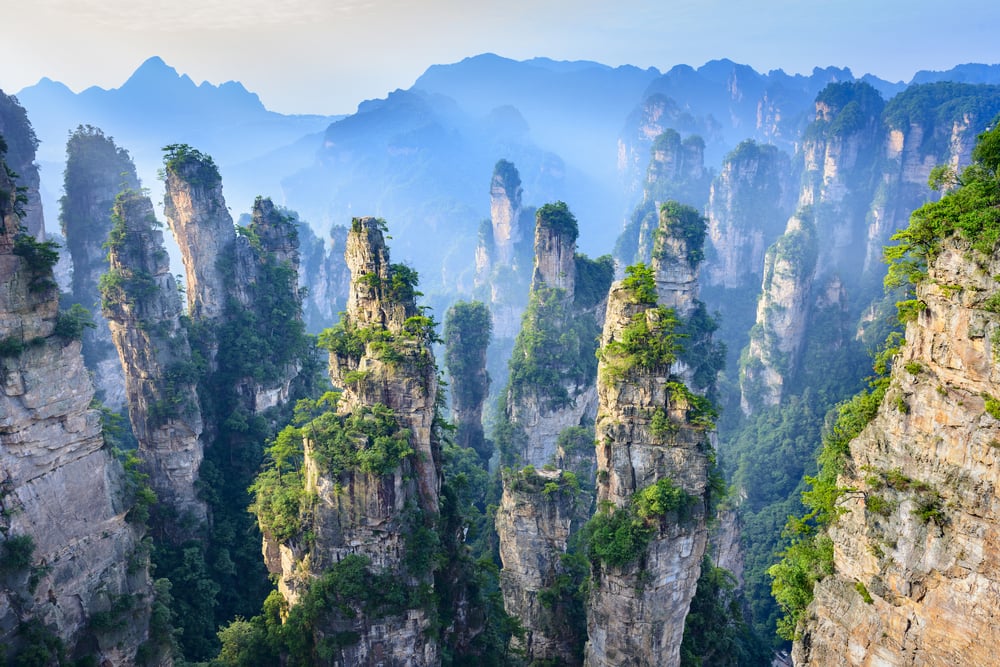
What is the Landform in Zhangjiajie?
Zhangjiajie National Forest Park is famous for its pillar-like formations, which are a distinct type of landform. These unique geological features were formed over millions of years through a combination of tectonic uplift, erosion, and weathering processes.
Landform Formation
The unique landforms in Zhangjiajie are the result of a long and complex geological history.
Uplift of the Quartz Sandstone
The story of Zhangjiajie's landscape began millions of years ago when the area was a vast basin. Over time, sediments, primarily quartz sandstone, accumulated in this basin, layer upon layer. These layers were compressed and cemented together, forming a solid mass of rock.
Around 2.6 million years ago, the Earth's tectonic plates shifted, causing a phenomenon known as neotectonics. This process resulted in the dramatic uplift of the entire region, including the quartz sandstone bedrock. As the land rose, the once flat-lying sandstone layers were tilted and fractured, creating joints and fissures – weaknesses within the rock.
Role of Running Water
With the uplift, rainwater, aided by gravity, began to flow over the exposed sandstone. The water seeped into the joints and fissures, gradually widening and deepening them over time. The quartz sandstone, though hard, was no match for the persistent erosive power of water, especially when channeled through these weaknesses.
| Erosion Process | Description |
|---|---|
| Physical Weathering | The force of the water flowing through the cracks widened them. Repeated freezing and thawing of water within the cracks also contributed to the breakdown of the rock. |
| Chemical Weathering | The slightly acidic rainwater reacted with the minerals in the sandstone, dissolving some of them and further weakening the rock. |
As the erosion progressed, the initial cracks widened into valleys, separating the sandstone plateau. The remaining, more resistant sections of sandstone, sculpted by the relentless carving action of water, eventually took on the dramatic shapes we see today.
Types of Landforms
The combined effects of tectonic uplift, erosion, and weathering have resulted in a diverse range of landforms in Zhangjiajie:
| Landform | Description |
|---|---|
| Mesas | These are large, flat-topped hills with steep sides. They represent remnants of the original sandstone plateau, where erosion has not yet fully carved them into smaller formations. |
| Tablelands | Similar to mesas but often larger and more extensive, tablelands are elevated plateaus with relatively flat tops and steep cliffs. |
| Peak Walls | These are towering, vertical cliffs that rise hundreds of meters high. They are formed by the erosion of the sandstone along parallel joints. |
| Peak Forests | The most iconic landform in Zhangjiajie, peak forests are collections of tall, slender sandstone pillars that resemble a dense forest. They are created when erosion isolates individual columns of rock. |
| Single-Peak Groups | These are isolated sandstone pillars that stand alone or in small clusters. They represent the final stages of erosion, where most of the surrounding rock has been carried away. |
Q&A
What type of rock forms the pillars in Zhangjiajie?
The pillars in Zhangjiajie are primarily composed of quartz sandstone.
What is the main force that shaped the landforms in Zhangjiajie?
While tectonic uplift set the stage, the main force that shaped the landforms in Zhangjiajie is water erosion.
How long did it take for these landforms to develop?
The landforms in Zhangjiajie are the result of millions of years of geological processes.
note: This return of all, without the author's permission, may not be reproduced